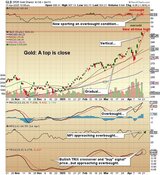You heard the saying, but what does it really mean? We live in a world where performance is stressed. Hedge funds can be measured on a monthly basis. Twenty percent charges on profits are levied by fund making their view short-term. Daily assessments are made, comparing one sector to another giving the impression that short-term performance is what it’s all about. But is it? No it is not.
Just look at where real wealth resides and why it’s there. Old Money means wealth held for many generations. How can wealth be held in this way, and how was it made up? While that’s a huge subject and one we cannot cover here, it’s important for you to realize that this was not made on a monthly, trading basis. It certainly was not made through day or week or month trading. Many traders do well several times and then on a "certainty," go into an investment that costs them their past profits, and more—this is more akin to gambling. Looking at a month to month trading performance as the measure of investing ability, the investment manager is being measured on his ability to trade short-term and not on his investment abilities. Genuine wealth-building ability is a far broader subject than this, as the wealthy know.
It is possible to trade well. We do know of a trader who consistently made exceptional profits over a long period. He chose a share that was out-of-sight from the general market in London—a tin share called Ayer Hitam in central Malaysia. The chart pattern was an even, consistent set of waves that followed the same highs and lows over time. He would follow that and buy low and sell high while it stayed below the market's radar. He made an absolute fortune for himself, but his trading was very different from today's meaning of trader. One of our friends, a professional trader who hosts a trading site, confirmed that 52% of trades succeed. The profits are entirely dependent on the trader and his ability to manage technical analysis and not the underlying investment. Fundamentals are not considered such a high priority in such trading. The point we want to emphasize is that trading is not investing!
Through my own experience as a fund manager, I've learned that by far the most successful strategy and wealth-builder is to take a long-term approach and only trade the occasional mid-term major corrections, aiming at 30% moves, or so. The emphasis of successful investing focuses on investments that do well in the bad times. Select investments that can withstand the sort of tribulations we've seen in the last four and a half years and you can see that not losing money or profits ensures that you can build your wealth when the times are good. This requires a deeper approach to investing, covering economics, finance and business; it more than just "punting" the charts. But that's real wealth creation investing, still there when you retire or die. And after all, isn't it true that the best investor is the one that has made the most when he dies?
One of the most successful wealth creating vehicles of the past 30 years has been a share called De Beers, a diamond company with a difference. . .
De Beers
In 1980 the South African diamond company De Beers stood at around Rand 30 on the Johannesburg Stock Exchange. It did well in the previous century, but let us begin with 1980—it paid a dividend of 1% every year; however, it had certain winning ingredients. Its cash balances were roughly the same as its total share worth, or when it felt that it was better to hold diamonds themselves, the value of those diamonds equalled its total share value. The business came into its value for nothing. It successfully marketed the saying "Diamonds are Forever," or as Marilyn Monroe put it, "Diamonds are a girl's best friend."
This remains a successful formula. More importantly, De Beers managed to dominate the Diamond market on the supply front and could almost name its prices. It was a near-monopoly, supported by most if not all the world's diamond producers. Until the Oppenheimer family took De Beers off the market at a price of R340, a share in the last few years (still paying it regular 1% dividend) this was a share that served that investor generation well. It was held as a constant hold in portfolios and not usually traded. It more than justified its presence there! In good times they acquired cash through diamond sales; in bad times they acquired stock. Throughout that period, the share held its value in terms of assets owned. Its liquidation value almost always matched its share price. Pension funds and pensioners couldn't have done better. Today, that monopoly has been broken, and the Oppenheimer family has just sold their shares in the company to Anglo American.
Today the sellers of those shares need a place to park their wealth at least if not a replacement investment. These are among those people who buy gold because they have money!
Where Can You Find Such an Investment Today?
Today, that skill is still needed when you make your choice of what to invest in. So how do you find such an investment?
Take a look at the environment that De Beers operated in—particularly from the end of the Second World War. Recovery, the growth of wealth across the developed world was the theme that took the developed world from war's end to 1980. Then currency confusion and inflation set in, to be cured by Volker in the U.S. raising interest rates to 25%. From then on, economic global expansion took the U.S. and the developed world to its heyday in early 2007. Then just as had happened in 1914, when the British Empire reached its zenith, the dreams of continually growing wealth were shattered by a credit crunch that we're still seeing rampaging throughout the Western world.
An examination of the causes and potential for worse to come tells us that in the four years since then, Western world leaders have failed to correct the structural faults. A further look tells us that the foundation structures of the developed world are crashing into each other and appear nowhere near solving the problems than they were when it started. What does this point to in the future?
The hold the U.S. has had on the global economy alongside the dominance of the U.S. dollar on the world's financial system is waning and infested with its own long-term problems. China and India together with their satellite Asian nations are sucking the wealth out of the West slowly but surely. At some point in the future, the dollar will have to give ground to the Chinese yuan. The emerging world will have as much say as the West will have on global matters. But the financial world was not designed for that. It was designed for dollar hegemony. The influence and power of the West will have to shrink and with a great deal of difficulty and protest. The world will come under diverse influences, with international trust and interdependence suffering as a result. It will be a very uncertain, if not unstable world we move into—far more so than now.
It's in this climate that a successful investor must operate. Changing times will be the investment theme of the future. So how can one choose an investment that suits this scene? The exact science of hindsight tells us that we should have had this discussion in the year 2005. That year would have been a good time to get out of mainstream companies in the West and into gold. Not only would one have secured profits but would have climbed aboard an investment that has risen more than fivefold in seven years. Silver has done even better. But hindsight thinkers are facing the wrong way. What does the future hold?
Expect the leaders of the financial and political world to give us more of the same flailing about in problems they're not authorized by profits or voters to resolve. This will continue until the criteria of profits and voters are changed by circumstance—if it should ever happen. Until then bad time investments will continue to do well. Investments that have done well in bad times since 2007 will continue to do well. Leading that pack are gold and silver bullion as well as the derivatives and mining company shares producing them.
Retaining Wealth
The theme we see going forward is to keep hold of what you have made. The emphasis remains on keeping wealth more than it does on making new wealth. This is the time to invest in something that will do well in bad times. The good times will see these investments do just as well if not better. Gold and silver will continue to be at the forefront of well-performing, bad time investments.
So why are people not buying gold to make money? This is one of those saying that seem so neat that they are more remembered than thought about. Alan Greenspan put it more succinctly, when he said "Gold is money in extremis."
- When a market has topped and interest rates rise, the only place to be is in cash.
- When hope in the future and potentially damaging problems abound in cash itself as well as markets, non-national cash is the place to be.
- When you believe that these problems will persist until fundamental changes are made in the global financial system so that it recovers and grows, you hold global cash until that time.
With little sign of the hoped-for, effective reforms of the financial system and future stability and growth, the time to move out of that global cash has not arrived, and the only globally-accepted, all situations "cash" is gold!
There will be the occasional situation where individual companies or assets outperform gold, but a core investment for the bulk of investors that want wealth protection remains precious metals—in particular gold and to a lesser, but potentially more profitable, silver.
Get the rest of the report. Subscribe @
www.GoldForecaster.com / www.SilverForecaster.com
Legal Notice / Disclaimer
This document is not and should not be construed as an offer to sell or the solicitation of an offer to purchase or subscribe for any investment. Gold Forecaster - Global Watch / Julian D. W. Phillips / Peter Spina, have based this document on information obtained from sources it believes to be reliable but which it has not independently verified; Gold Forecaster - Global Watch / Julian D. W. Phillips / Peter Spina make no guarantee, representation or warranty and accepts no responsibility or liability as to its accuracy or completeness. Expressions of opinion are those of Gold Forecaster - Global Watch / Julian D. W. Phillips / Peter Spina only and are subject to change without notice. Gold Forecaster - Global Watch / Julian D. W. Phillips / Peter Spina assume no warranty, liability or guarantee for the current relevance, correctness or completeness of any information provided within this Report and will not be held liable for the consequence of reliance upon any opinion or statement contained herein or any omission. Furthermore, we assume no liability for any direct or indirect loss or damage or, in particular, for lost profit, which you may incur as a result of the use and existence of the information, provided within this Report.







































